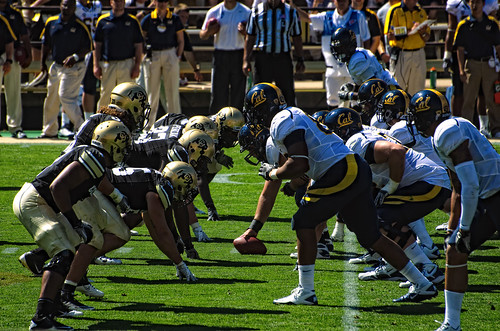The Chronicle of Higher Education has conducted an eye-opening analysis of the contracts of the presidents of the 25 biggest athletics departments in state universities. Here is what they found:
Of the presidents or chancellors who oversee the 25 biggest athletic departments, not a single one has contract language related to oversight of athletics. That includes Rodney A. Erickson, who was named president of Penn State following a breakdown in university leadership during the Jerry Sandusky sex-abuse scandal. Employment agreements for top officials at Ohio State University and the University of North Carolina at Chapel Hill, which have both faced major NCAA sanctions in the past year, do not spell out any specific powers.The University of Colorado, where I am a faculty member, is not among the 25 largest athletic departments so it wasn't included in the study. I had a look at the "Laws of the regents" which is the top-level governance document for the university, to see where athletics sits.
More common in presidential contracts, The Chronicle found, were specific goals for fund raising and financial management. If athletics was mentioned at all, it was to spell out perks the presidents would receive, such as free lifetime tickets to games.
Campus chiefs are held accountable for sports in various ways, including through individual performance reviews or their institutions' accreditation processes. But contract provisions are one of the measures governing boards use to assess presidential performance.
Governance experts say boards should do a better job of spelling out their leaders' athletics responsibilities to protect institutions from conflicts with boosters and outside parties, and to guard against potential fallout from scandal.
First, the University of Colorado mission statement:
The University of Colorado is a public research university with multiple campuses serving Colorado, the nation, and the world through leadership in high-quality education and professional training, public service, advancing research and knowledge, and state-of-the-art health care.There is no mention of athletics in the mission, which is consistent with the findings reported by Charles Clofelter in his excellent book, Big-Time Sports in American Universities. Clofelter finds that despite the prominence of sports in major US universities, their presence is neglected when it comes to formal statements of mission and objectives. That fidning is similar to what the Chrinicle found of presidential contracts.
That said, the University of Colorado does have an Intercollegiate Athletics Policy, which specifies who is in charge (emphasis added):
Intercollegiate athletic competition at the University of Colorado commenced in 1890. Since that time, athletics have continued to be an integral part of the university's educational offerings and student activities. At the present time, teams in a wide variety of sports compete at local, regional, and national levels.The Regent policy also appears to contain a provision that suggests free tickets for the Regents, but I digress. The University of Colorado is a "system" of campuses, and CU-Boulder is the only campus with a big-time athletic program. Our Chancellor is given explicit responsibility for CU-Boulder athletics oversight.
Each campus may support intercollegiate athletic teams at appropriate levels of competition and as approved by the Board of Regents. Intercollegiate athletics provide opportunities for student development as well as a forum and opportunity to promote the individual campuses and the University of Colorado. The campus chancellors are responsible for the oversight and management of their respective athletic programs and related representational events. The chancellors will provide opportunities for the president and Board of Regents to attend and participate in athletic and related representational events that can enhance the image and outreach of the university.
The University of Colorado also has a policy on the Interrelationship of Athletics and Educational Programs:
Health Education, Physical Education, Recreation, and Intercollegiate Athletics are related areas which share common objectives and similar physical facilities. These disciplines and activities are financed through a combination of academic budgets, student fees, gate receipts, and from individual donations.Constructive outlets for the adventurous spirit -- a nice phrase, but I am not buying the notion that athletics are part of the instructional program. Universities have some work to do to shore up the governance of athletics.
Due to their related goals, they are important parts of one very significant University responsibility. The University recognizes the instructional value of all four of these areas of activity. They each interrelate for instruction not only at the undergraduate and graduate level but also provide a learning experience for life after leaving the University.
In particular, intercollegiate athletics are drama--tragedy and comedy. They are discipline and dedication. They are victory and defeat--elation and dejection. They are respect and discourtesy--sportsmanship and gamesmanship. They are constructive outlets for the adventurous spirit. They are a positive way of life that teaches our young to control their minds, bodies, and emotions through exciting competitions governed by the rules of the game. The Regents of the University recognize the interrelationship of these four areas as an integral portion of the University’s instructional program.

0 comments:
Post a Comment